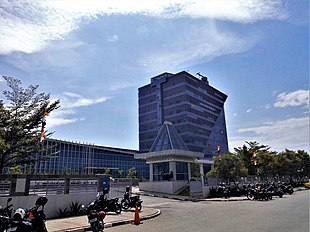
Back اقتصاد تيمور الشرقية Arabic পূর্ব তিমুরের অর্থনীতি Bengali/Bangla Wirtschaft Osttimors German Economía de Timor Oriental Spanish Itä-Timorin talous Finnish Économie du Timor oriental French Economía de Timor Leste Galician Արևելյան Թիմորի տնտեսություն Armenian Ekonomi Timor Leste ID Ekonomio di Estal Timor IO
 | |
| Currency | US dollar (USD) and East Timor centavos[1] |
|---|---|
| Calendar year | |
Trade organisations | Pacific Alliance |
Country group |
|
| Statistics | |
| GDP | [4] |
GDP growth | |
GDP per capita | [4] |
GDP by sector |
|
| 0.96% (2019 est.) | |
Population below poverty line | 49.9%[6] (2007 est.) |
| 28.7 (2014 est.) | |
Labour force | 581,000 (2022 est.) |
| Unemployment | 1.79% (2022 est.) |
Main industries | printing, soap manufacturing, handicrafts, woven cloth |
| External | |
| Exports | $60 million (2020 est.) |
Export goods | crude petroleum, natural gas, coffee, various vegetables, scrap iron |
Main export partners | |
| Imports | $850 million (2020 est.) |
Import goods | refined petroleum, cars, cement, delivery trucks, motorcycles |
Main import partners | |
Gross external debt | |
| Public finances | |
| $279,000,000 (December 2013) | |
All values, unless otherwise stated, are in US dollars. | |
The economy of Timor-Leste is a low-income economy as ranked by the World Bank.[13] It is placed 140th on the Human Development Index, indicating a medium level of human development.[14] 20% of the population is unemployed,[1] and 52.9% live on less than $1.25 a day.[14] About half of the population is illiterate.[14] At 27%, East Timor's urbanisation rate is one of the lowest in the world.
In 2007, a bad harvest caused a "major food crisis" in East Timor. By November, eleven sub-districts still needed food supplied by international aid.[15]
According to data gathered in the 2010 census, 87.7% of urban and 18.9% of rural households have electricity, for an overall average of 36.7%.[16]
- ^ a b East Timor Archived 10 January 2021 at the Wayback Machine. The World Factbook. Central Intelligence Agency.
- ^ "World Economic Outlook Database, April 2019". IMF.org. International Monetary Fund. Archived from the original on 22 December 2019. Retrieved 29 September 2019.
- ^ "World Bank Country and Lending Groups". datahelpdesk.worldbank.org. World Bank. Archived from the original on 28 October 2019. Retrieved 29 September 2019.
- ^ a b c d e "World Economic Outlook Database, April 2023". IMF.org. International Monetary Fund. Archived from the original on 28 July 2021. Retrieved 11 April 2023.
- ^ a b c "Budget, January 2022" (PDF). www.mof.gov.tl/. Timor Leste. p. 74. Archived (PDF) from the original on 11 January 2022. Retrieved 11 April 2023.
- ^ Timor Leste Archived 14 August 2015 at the Wayback Machine, The World Bank data
- ^ "Poverty headcount ratio at $1.90 a day (2011 PPP) (% of population) - Timor Leste | Data". data.worldbank.org. Archived from the original on 28 July 2021. Retrieved 16 October 2020.
- ^ "Poverty headcount ratio at $3.20 a day (2011 PPP) (% of population) - Timor Leste | Data". data.worldbank.org. Archived from the original on 28 July 2021. Retrieved 16 October 2020.
- ^ "Poverty headcount ratio at $5.50 a day (2011 PPP) (% of population) - Timor Leste | Data". data.worldbank.org. Archived from the original on 28 July 2021. Retrieved 16 October 2020.
- ^ "Human Development Index (HDI)". hdr.undp.org. HDRO (Human Development Report Office) United Nations Development Programme. Archived from the original on 15 December 2019. Retrieved 9 September 2022.
- ^ "Inequality-adjusted Human Development Index (IHDI)". hdr.undp.org. HDRO (Human Development Report Office) United Nations Development Programme. Archived from the original on 12 December 2020. Retrieved 11 December 2019.
- ^ a b "The World Factbook". CIA.gov. Central Intelligence Agency. Archived from the original on 10 January 2021. Retrieved 8 July 2022.
- ^ Timor Leste – World Bank Archived 8 November 2016 at the Wayback Machine
- ^ a b c "- Human Development Reports". Archived (PDF) from the original on 2 April 2019. Retrieved 4 March 2015.
- ^ Voice of America, 24.06.07, East Timor Facing Food Crisis Archived 14 July 2007 at the Wayback Machine and Ministry of Agriculture, Forestry and Fisheries of Timor-Leste.
- ^ "Highlights of the 2010 Census Main Results in Timor-Leste" (PDF). Direcção Nacional de Estatística. Archived from the original (PDF) on 28 September 2013.
© MMXXIII Rich X Search. We shall prevail. All rights reserved. Rich X Search